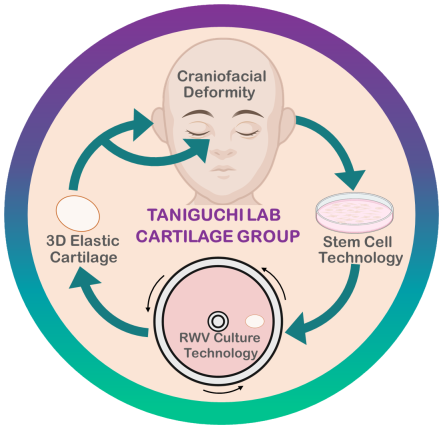ヒト耳介軟骨前駆細胞を用いた
スキャフォールドを必要としない弾性軟骨の再構成
鞍鼻・小耳症等の先天的な頭頚部形態異常疾患の治療では、低侵襲性かつ形態安定性の高い弾性軟骨移植が求められています。これまでに頭頸部領域の再建において、侵襲性の極めて高い自家肋軟骨が臨床的に使用されています。そのため、頭頚部形態異常疾患に対して侵襲性の低い治療法を確立するため、移植治療に利用可能なヒト弾性軟骨構造体の製造を実現化することが必須です。
そこで当研究室では、世界で初めて弾性軟骨への分化能を有するヒト軟骨前駆細胞の分離操作法の開発に成功しました。この独自性の高いヒト軟骨前駆細胞を活用し、足場材料を用いずにヒト弾性軟骨構造体を作製可能な、極めてユニークな三次元培養法を開発にも成功しています。
実臨床を想定したカニクイザルへの自家移植実験においても治療効果が確認できたため、現在First in Humanを目標に臨床化をすすめております。
Microtia, characterized by a small, abnormally shaped auricle, is one of the most common external ear abnormalities, with an incidence of 1–10 per 10,000 births. Auto-transplantation of costal cartilage segments is one of the most popular treatments. However, this strategy has disadvantages, such as the lack of elasticity of costal cartilage, difficulty in harvesting costal cartilage, and post-operative pain at the donor site. To this end, a system for establishing morphologically stable elastic cartilage using a cell source that is easy to access is necessary.
In our laboratory, we have shown the world’s first technology for separating and identifying cartilage precursor cells from the human auricular cartilage membrane with high purity. Using these cells, we have further succeeded in reconstructing the elastic tissue both in vitro and in vivo. Our major goal is to establish a non-invasive, novel promising treatment for patients with craniofacial cartilage deformity by transplanting this morphologically stable scaffold-free elastic cartilage structure.

